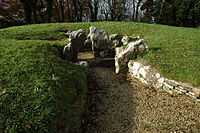Nympsfield Long Barrow

Nympsfield Long Barrow is the remains of a Neolithic burial site or barrow, located close to the village of Nympsfield in Gloucestershire, South West England.[1]
It lies at the edge of a woods, and is now the location of a picnic site.[1] It is one of the earliest examples of a barrow with separate chambers.[2] It was constructed around 2800 BCE.[3]
It is a Scheduled Monument (number 22857) in the guardianship of English Heritage.[4][5]
Many of the finds from excavations at this site are now in the Gloucester City Museum.
Location
Nympsfield Long Barrow is sited to the southeast of the B4066 road, around 6 miles (10 km) southwest of Stroud, and approximately 14 miles (23 km) west of Cirencester within Coaley Peak Country Park.[1] The tumulus is no longer visible.[1] In common with other barrows in the area it lies on the edge of a scarp of Jurassic oolitic (egg stone) limestone.[2][6]
Layout

The barrow is 27 by 18 metres in size and overall trapezoidal in shape. There is evidence of curving walls behind the east entrance, which leads into a square forecourt area, opening onto a central passage.[1] Three chambers lead off this passage, two larger chambers to either side and one small one to the end, divided off by constricting stones to restrict access.[7][8] A small part of the north chamber was separated off to form a cist.[9] The long axis of the barrow is orientated in a southeast to northwest direction.[1]
History of excavation
The barrow has been excavated on three separate occasions,[8] in 1862 by Buckman with the Cotteswold Naturalist's Field Club, in 1937 by E.M. Clifford and in 1974 by A. Saville.[10][11] Twenty three bodies were discovered within the site.[1] The remains of cremated children were placed in a separate cist.[6] It was noted that the majority had common medical problems including infections in the mouth and gums, and abscesses.[1] It is believed that, following interment, the bodies were left for a predetermined length of time, before a specific event took place, where the tomb was sealed over permanently.[1] Haematite was found in the mound, possibly used as face-paint to make the dead appear alive.[12]
The digs uncovered the remains of fires, and pig bones, within the forecourt, indicating that ritualized meals were eaten, during burial ceremonies.[1] Some dog bones were also uncovered on the site, but it is uncertain whether they age back to the original site, or from a later date.[13] At the time of the first excavation, Nympsfield was thought to be unique in being the only chambered barrow in which bones from birds had been discovered,[13] although several other such sites have now been discovered, such as the Tomb of the Eagles in the Orkney Islands.[14]
A leaf-shaped arrow-head and shards of pottery were also discovered.[8] Two reconstructed vessels, a bowl and a necked jar, have been attributed to Ebbsfleet ware.[15] Quartz pebbles were noted amongst the blocking deposits at both ends of the mound. This is a common feature of many long barrows in the Cotwold-Severn group, in north Wales and northern and central Ireland and is thought to have a symbolic meaning.[16]
Nympsfield Long Barrow is part of the Cotswold-Severn group of monuments. It is similar in layout to the chambered tombs of Uley and Notgrove. It lies close to the so-called "Soldier's Grave" round barrow.[7] The site was also occupied in both the Iron Age and Roman times.[17]
References
- ↑ 1.0 1.1 1.2 1.3 1.4 1.5 1.6 1.7 1.8 1.9 Lord Montagu of Beaulieu (1987). P.H. Reed, ed. English Heritage. Hampstead Road, London: English Heritage / Macdonald Queen Anne Press. p. 81. ISBN 0-356-12773-7.
- ↑ 2.0 2.1 Leslie V. Grinsell (1958), The archaeology of wessex, Methuen, p. 10
- ↑ Kev Reynolds (2007), The Cotswold Way: Two-Way National Trail Description, Cicerone Press Limited, ISBN 978-1-85284-552-0
- ↑ http://www.pastscape.org.uk/hob.aspx?hob_id=113212
- ↑ National Monuments Records: English Heritage
- ↑ 6.0 6.1 Edmonds, M. (2002). Ancestral Geographies of the Neolithic: Landscapes, Monuments and Memory. Routledge. pp. 63, 65. ISBN 978-0-203-02019-7. Retrieved 1 December 2010.
- ↑ 7.0 7.1 Darvill, T.; Stamper, P.; Timby, J. (2002). England: an Oxford archaeological guide to sites from earliest times to AD 1600. Oxford archaeological guides. Oxford University Press. p. 296. ISBN 978-0-19-284101-8. Retrieved 1 December 2010.
- ↑ 8.0 8.1 8.2 Castleden, R. (1992). Neolithic Britain: new stone age sites of England, Scotland, and Wales. Routledge. p. 112. ISBN 978-0-415-05845-2. Retrieved 1 December 2010.
- ↑ Staelens, Y.J.E. (1982). "The Birdlip Cemetery". Transactions of the Bristol and Gloucestershire Archaeological Society 100: 19–31. Retrieved 1 December 2010.
- ↑ Daniel, G.E. The Prehistoric Chamber Tombs of England and Wales. Cambridge University Press. p. 222. Retrieved 1 December 2010.
- ↑ Darvill, T.C.; Grinsell L.V. (1989). "Gloucestershire barrows: supplement 1961–1988". Transactions of the Bristol and Gloucestershire Archaeological Society 107: 40. Retrieved 1 December 2010.
- ↑ Clifford, E.M. "Graves found at Hailes, Gloucestershire". Transactions of the Bristol and Gloucestershire Archaeological Society 65: 187–198. Retrieved 1 December 2010.
- ↑ 13.0 13.1 Society of Antiquaries of London (1869), Archaeologia, Or Miscellaneous Tracts Relating to Antiquity, Volume 42, Part 1, General Books LLC, retrieved 2010-11-21
- ↑ "The Tomb of the Eagles". Retrieved 1 December 2010.
- ↑ Smith, I. (1968). "Report on Late Neolithic Pits at Cam, Glos". Transactions of the Bristol and Gloucstershire Archaeological Society 87: 27. Retrieved 1 December 2010.
- ↑ Darvill, T. (2002). "White on blonde: Quartz pebbles and the use of quartz at Neolithic monuments in the Isle of Man and beyond". In Jones A. & MacGregor G. Colouring the past: the significance of colour in archaeological research. Berg Publishers. pp. 73â91. ISBN 978-1-85973-547-3. Retrieved 1 December.
- ↑ Woodcock, R. (1998). A year of walks in the Cotswolds. Sigma. p. 110. ISBN 978-1-85058-608-1. Retrieved 1 December 2010.
External links
| Wikimedia Commons has media related to Nympsfield Long Barrow. |
51°42′37″N 2°17′59″W / 51.71025°N 2.29970°WCoordinates: 51°42′37″N 2°17′59″W / 51.71025°N 2.29970°W